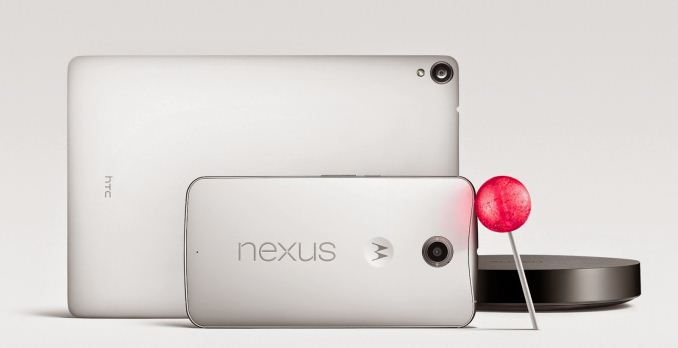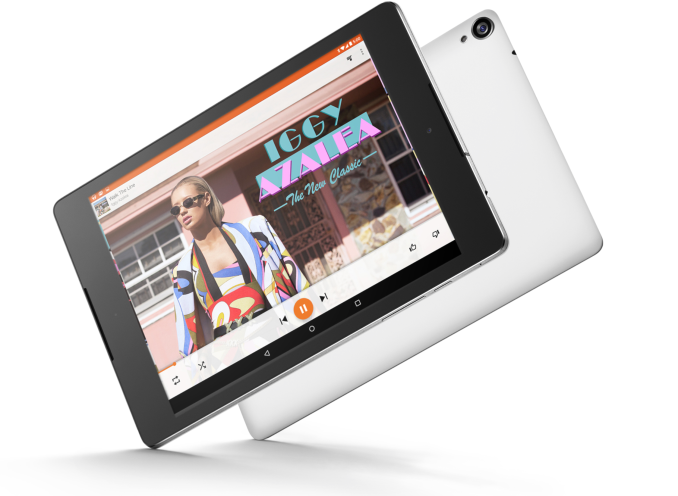Google Announces the Nexus 6 and Nexus 9 Running Android Lollipop
by Brandon Chester on October 15, 2014 12:33 PM EST
Today Google has officially announced the newest devices in the Nexus line, just one day before Apple's October event. Both devices have been rumored for some time now, and this is the first time in a while that we've seen Google introduce a new smartphone and tablet at the same time. The first device in the announcement is the Nexus 6, made by Motorola. The second is the Nexus 9 tablet made by HTC. To give an overview of how both devices look on paper, I've put together their specifications in a chart below.
| Nexus 6 | Nexus 9 | |
| SoC | 2.7GHz Snapdragon 805 (APQ8084) with 4 x Krait 450 + Adreno 420 at 600MHz | 2.3GHz 64-bit dual core Tegra K1 Denver SoC |
| RAM/NAND | 3GB LPDDR3 + 32/64GB NAND | 2GB LPDDR3 + 16/32GB NAND |
| Display | 5.96" 2560x1440 AMOLED | 8.9" 2048x1536 IPS LCD |
| Network | 2G / 3G / 4G LTE | WiFi only or 2G / 3G / 4G LTE SKU |
| Dimensions | 82.98 x 159.26 x 10.06mm, 184g | 153.68 x 228.25 x 7.95mm, 425g WiFi, 436g LTE |
| Camera | 13MP Rear Facing with F/2.0 aperture and OIS, 2MP FFC 4K video recording |
8MP Rear Facing with F/2.4 aperture, 1.6MP FFC |
| Battery | 3220 mAh (12.236 Whr) | 6700 mAh (25.46 Whr) |
| OS | Android 5.0 Lollipop | Android 5.0 Lollipop |
| Connectivity | 802.11a/b/g/n/ac + BT 4.1, USB2.0, GPS/GNSS, NFC | 802.11a/b/g/n/ac + BT 4.1, USB2.0, GPS/GNSS, NFC |
| SIM Size | NanoSIM | NanoSIM on LTE SKU |
 The Nexus 6 features a similar appearance to Motorola's other devices like the Moto X and Moto G. The plastic back is surrounded by a contoured aluminum frame that curves downward at the top where the 3.5mm headphone jack is located. On the back is Google's traditional Nexus logo, accompanied by an indented motorola logo and a centered rear-facing camera. The front is dominated by a large 5.96" display with a pixel density of 493ppi, and stereo speakers on the top and bottom bezels.
The Nexus 6 features a similar appearance to Motorola's other devices like the Moto X and Moto G. The plastic back is surrounded by a contoured aluminum frame that curves downward at the top where the 3.5mm headphone jack is located. On the back is Google's traditional Nexus logo, accompanied by an indented motorola logo and a centered rear-facing camera. The front is dominated by a large 5.96" display with a pixel density of 493ppi, and stereo speakers on the top and bottom bezels.
In terms of its specifications, the Nexus 6 is competitive with all the current Android flagship devices. It packs Qualcomm's latest silicon, a hefty battery, and a high resolution display. However, those premium specs are accompanied by a premium price of $649 outright which is significantly more than the $349 that the Nexus 5 is priced at. The Nexus 5 has been given a new web page along with the other Nexus devices which suggests it isn't going disappear with the launch of this newer, more expensive smartphone.
The next announcement was the Nexus 9 made by HTC. This is the first tablet from HTC since the days of Android Gingerbread and Honeycomb where HTC announced they were exiting the tablet market. With its soft touch back, the Nexus 9 is similar in its design to the Nexus 5. Unlike the Nexus 5 which was an entirely plastic construction, the sides of the Nexus 9 are made of brushed metal.
The front of the device is similar to the Nexus 7 with its asymmetrical bezels. The shape of the device is a departure from any tablet Google has produced before, with a 2048x1536 4:3 display like Apple's iPad. Both the 8.9" display size and 4:3 aspect ratio make the Nexus 9 a significantly larger device than the Nexus 7.
The SoC is the biggest point of interest with the Nexus 9. It will be the first device to ship with Nvidia's Project Denver architecture. This is a custom 64-bit ARMv8 architecture designed by Nvidia, a significant departure from the standard ARM cores used in previous Tegra chips. We covered the details about Tegra K1 Denver previously and you can read that over to get a more in-depth look at NVIDIA's new chip.
Along with the new device announcements comes the official name for the next version of Android. Android L is now Android 5.0 Lollipop, and it will ship on the new Nexus 6 and Nexus 9. Lollipop comes with Google's new Material Design and Google's new ART runtime, and will be rolling out to existing compatible Nexus and Google Play Edition devices in the coming weeks.
The Nexus 9 will be available for pre-order on October 17th starting at $399 for 16GB, while the Nexus 6 will be available sometime in late October at $649 for 32GB.
Source: Google Blog











148 Comments
View All Comments
Ortanon - Wednesday, October 15, 2014 - link
They don't really make very many 3:2 desktop monitors. But I'd wager money that if they did, creators would buy them. 16:9 is great for YouTube, but people who make stuff on their computer or multitask heavily often go to 16:10, and I suspect that if 3:2 was more of an option you'd see that too.Impulses - Thursday, October 16, 2014 - link
Ehh, it really depends on what your end goal or usage case is, there's way too many people here making broad generalizations. I love my 24" 16:10 Dell displays and I chose them largely because of it, but gaming is a big part of the reason I have a desktop so I'd never trade them for 3:2 displays either.16:10 just works great for me even in Eyefinity (and makes for a pretty versatile PPP or LLL landscape). If anything I'd opt for 3:2 side displays but that would kill PPP use...
Even if you're talking strictly content creation you're still generalizing unless you specify the content. No one editing video is gonna opt for a more square display, and even those working with photos often want a wider display for tools, palettes, and layer controls around the photo.
That's hardly the end of content creation tho, people working in print, web content or programming might very well have no use for a wider display, unless of course it's wide enough and large enough to display two side by side pages.
So really, desktop is just about the worst place for broad generalizations.
SirKnobsworth - Wednesday, October 15, 2014 - link
Everyone copies everyone else in the mobile sector these days. I think it's time we stopped worrying about who is guilty of what :PJimmaDaRustla - Wednesday, October 15, 2014 - link
Perhaps I'm misinterpreting your comment, but an iPhone 6 Plus is $859 for a 16GB, Nexus 6 is $210 cheaper for 32GB?mkozakewich - Wednesday, October 15, 2014 - link
The iPhone 6 Plus is USD$750. And it's a $100 upgrade over the iPhone 6, which is the same price as the Nexus 6, but I'm not sure that's relevant.Either way, a Nexus will be cheaper than any manufacture-sold phones with the same components. I'm pretty sure Google is selling them at or near cost. The fact that this one is so high-end and so (relatively) expensive says something about its abilities.
testbug00 - Thursday, October 16, 2014 - link
This nexus is not sold in line with cost. The slightly faster SoC + higher res screen + 16GB more storage + misc __IS NOT__ $300 more than the Nexus 5.If this phone costs over 125USD to make over the Nexus 5 I would be shocked.
Bob Todd - Wednesday, October 15, 2014 - link
Enough with the FUD already. Even the GNex with TI internals got the 4.3 update 20+ months after it was released. The 2 year old Nexus 4 is getting Lollipop. If you want Android and really care about updates, the Nexus line is still really your only choice (we'll see if Moto continues its excellent update streak going under Lenovo).hpglow - Wednesday, October 15, 2014 - link
If Apple wants anymore of my money they need to patch the stuttering and crashes in iOS 8. I own two iPhone 5 and they are both dogs now. I wouldn't have patched but I wanted SwiftKey, something that my Android devices have had for a while. I don't care about specs one of the reasons for buying Apple products has been it's smooth responsive UI even on low end hardware. Having to wait over a second for a webpage to rerender after zooming or scrolling sucks.Apple needs to pull something out of its hat soon or the two iPhone 5 I own are getting sold for a $200 bill credit in favour of a note 4, or OPO.
sweetca - Thursday, October 16, 2014 - link
Yeah, I don't know if this will push me to Apple. However, this completely changes the dynamic of the Nexus Performance/Value proposition.Ortanon - Wednesday, October 15, 2014 - link
$650 is pretty hard to swallow, considering the history of Nexus pricing structures.